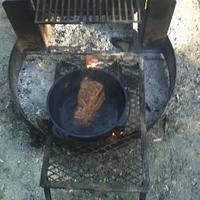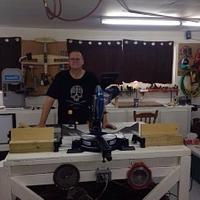17 Replies
One answer is to use plywood for the panels and epoxy them in. Floating panels are not a seaworthy construction.
I have done lots of raised panel doors for sailboats where the doors are not large using half lapped corner joints and glued in panels, all epoxy. I have never had a failure. Red Cedar however, while high in rot resistance, is not anywhere near as dimensionally stable as teak and not really hard enough to take the beating that doors get.
Another possibility if the doors are larger is to glue/seal the doors in with a polysulfide (like Thiokol) or polyurethane (like Sikaflex) which have some give and stretch a little.
How big are the doors and what kind of boat is it?
The early bird gets the worm but its the second mouse that gets the cheese.
It’s a 36 foot Bayliner cabin cruiser from the early 80’s. The door is 3 feet wide and 4 feet tall. There is a top hatch over the accordion doors to cover the top of the opening that is in reasonably good shape. The boat is a deep V hull, certainly capable of coastal ocean waters. In fact, based on some the tax and licensing receipts included in the papers on board, this boat used to live in the Chesapeake Bay. Even so, she is spending her declining days on the Tennessee River, and a high level of seaworthiness is desirable, but not as critical as it once was.
The owner of the boat is retired on disability and lives aboard. As such, teak is financially out of reach. What I build needs to last a very long time as funds to repair or replace will be hard to come by. Plywood is also out as I was specifically told, “none of that cheap plywood or particle board crap.”
Sadly plywood would be his best option. Something like Bruynzeel or a good Okoume would look very good and not give the expansion problems of a solid panel.
The early bird gets the worm but its the second mouse that gets the cheese.
I think you are right. I have no experience at all with marine plywood. Can you suggest a source for small quantities, and where to read up on the topic?
I’m meeting with him this weekend to finalize design details and I’ll make another run at the idea of marine plywood panels.
Failing that, what wood would you suggest for low cost and rot resistance if not red cedar?
In my area a good substitute for red cedar is yellow (Alaska) cedar. It is harder, stronger and equally rot resistant. However that is in the Pacific Northwest so I don’t have any low cost options or even marine plywood sources for you in your area. You should be able to do some google research on the topic and find a nearby supplier.
My second choice after teak would be Honduras Mahogany but it’s not exactly cheap either. Unfortunately boats require good material and it just isn’t cheap.
Sorry I can’t help more.
The early bird gets the worm but its the second mouse that gets the cheese.
ok, thanks for your time :-)
Use the best wood you can get in the area, the best construction you know and the best finish you can put on. Then I think you will have a happy boat owner.
I would think of using cypress. It does not rot,but will soak up a lot of water if the finish is not maintained.
Tor and Odin are the greatest of gods.
If none of shipwrights woods are available, you might consider juniper, it’s legendary wrotting resistance. It’s similar in grain and knots to spruce. It is a softwood that is harder than most. I only suggest it as I have used it on a sailboat before for an interior remodel. It’s benefit is coat, relatively cheap. If water ever did get at it like the old doors wrotting would not happen.
CHRIS, Charlottetown PEI Canada. Anytime you can repurpose, reuse, or recycle, everyone wins!
Madts, cypress was actually my first thought, but the janka hardness on it is 550, WAY too soft for a door that is going to be banged around. Eastern Red Cedar has a janka of 990, which is why I thought of it.
For whatever reason, furniture grade hardwood is really hard to to come by here in North Alabama. I managed to set up an account with United Plywood, but the local branch manager is such an arrogant prig I do my best to avoid doing business with them. My preferred source for lumber is a local guy who saws local logs. The only down side is that limits my selection pretty sharply. I don’t know for sure that I could get juniper.
Because of my supplier my wood choices are pretty much limited to red oak, hickory, eastern red cedar, cherry, walnut, sassafras, poplar, and maple. Sometimes he has red elm, white oak, and a few others, but not very often. I really wish I had a broader selection to work with, but not that many people seem to be woodworking any more. :-(
Stay away from red oak. It absorbs lots of water and rots very easily.
White oak would be good.
The early bird gets the worm but its the second mouse that gets the cheese.
Yeah, I watched a YouTube video if a piece of red oak pit in a bowl of alcohol with red food coloring in it. Pretty shocking how quick it sucked it up.
Just checked with my sawmill guy. He has a load of white oak that came out of the kiln yesterday. It’s going to be in the shed resting for a week or so, then it will be ready to go. Looks like white oak it is then.
White oak is a great boat wood but I’d still like to see plywood panels if it were my boat.
The early bird gets the worm but its the second mouse that gets the cheese.
So, what do you recommend for a marine finish on white oak?
Best grade marine vanish. First coats thinned to about 50%. About ten coats should do it depending on where you live. Make sure it has a UV filter in it.
Tor and Odin are the greatest of gods.
Best grade marine vanish. First coats thinned to about 50%
Tor and Odin are the greatest of gods.
Personally, I like Cetol marine ….. but that’s because I’m a little lazy about keeping up the varnish.
The early bird gets the worm but its the second mouse that gets the cheese.












